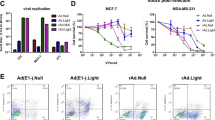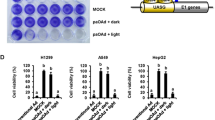Abstract
Since RGD fiber-mutant adenovirus vector (AdRGD), which contains an αv-integrin tropism, is highly efficient in gene transduction to melanoma, the AdRGD-mediated herpes simplex virus thymidine kinase (HSVtk)/ganciclovir (GCV) system is an attractive approach for melanoma treatment. However, the intratumoral injection of AdRGD causes limited transgene expression in healthy normal tissue, due to unwanted vector spread. Herein, we describe our attempt to overcome this limitation related to the safety of HSVtk/GCV treatment by using AdRGD carrying either melanoma-specific tyrosinase (Tyr) promoter or tumor-specific telomerase reverse transcriptase (TERT) promoter instead of universal cytomegalovirus promoter. Our in vitro study revealed that Tyr promoter-regulated AdRGD exhibited high transgene expression specificity for melanoma cells, and that TERT promoter-regulated AdRGD could induce efficient gene expression in tumor cells, but was relatively quiescent in normal cells. Anti-B16BL6 melanoma effects in mice injected intratumorally with AdRGD-Tyr/HSVtk or AdRGD-TERT/HSVtk, after which GCV was injected intraperitoneally for 10 days, were comparable to those in mice injected with AdRGD-CMV/HSVtk at 10 times less vector dosage. On the other hand, AdRGD-Tyr/HSVtk and AdRGD-TERT/HSVtk did not induce severe adverse effects even when they were intravenously injected into mice at 109 plaque-forming units (PFU), whereas mice injected with AdRGD-CMV/HSVtk at 108 PFU exhibited body weight reduction and serum level increase of biochemical enzymes for hepatotoxicity. These results indicate that AdRGD combined with transcriptional regulation using Tyr or TERT promoter is a potentially useful and safe vector system for suicide gene therapy for melanoma.
This is a preview of subscription content, access via your institution
Access options
Subscribe to this journal
Receive 12 print issues and online access
$259.00 per year
only $21.58 per issue
Buy this article
- Purchase on Springer Link
- Instant access to full article PDF
Prices may be subject to local taxes which are calculated during checkout





Similar content being viewed by others
Abbreviations
- Ad:
-
adenovirus vector
- AdRGD:
-
RGD fiber-mutant adenovirus vector
- FBS:
-
fetal bovine serum
- GCV:
-
ganciclovir
- GOT:
-
glutamic oxaloacetic transaminase
- GPT:
-
glutamic pyruvic transaminase
- HSVtk:
-
herpes simplex virus thymidine kinase
- MOI:
-
multiplicity of infection
- MTT, 3-(4,5-dimethylthiazol-2-yl)-2:
-
5-diphenyl tetrazolium bromide
- PFU:
-
plaque-forming unit
- PBS:
-
phosphate-buffered saline
- RLU:
-
relative light unit
- TERT:
-
telomerase reverse transcriptase
- Tyr:
-
tyrosinase
References
Schadendorf D . Gene-based therapy of malignant melanoma. Semin Oncol. 2002;29:503–512.
Prehn RT . The paradoxical association of regression with a poor prognosis in melanoma contrasted with a good prognosis in keratoacanthoma. Cancer Res. 1996;56:937–940.
Wildemore IV JK, Schuchter L, Mick R, et al. Locally recurrent malignant melanoma characteristics and outcomes: a single-institution study. Ann Plast Surg. 2001;46:488–494.
Ram Z, Culver KW, Walbridge S, Blaese RM, Oldfield EH . In situ retroviral-mediated gene transfer for the treatment of brain tumors in rats. Cancer Res. 1993;53:83–88.
Sterman DH, Treat J, Litzky LA, et al. Adenovirus-mediated herpes simplex virus thymidine kinase/ganciclovir gene therapy in patients with localized malignancy: results of a phase I clinical trial in malignant mesothelioma. Hum Gene Ther. 1998;9:1083–1092.
Klatzmann D, Valery CA, Bensimon G, et al. A phase I/II study of herpes simplex virus type 1 thymidine kinase ‘suicide’ gene therapy for recurrent glioblastoma. Study Group on Gene Therapy for Glioblastoma. Hum Gene Ther. 1998;9:2595–2604.
Shand N, Weber F, Mariani L, et al. A phase 1-2 clinical trial of gene therapy for recurrent glioblastoma multiforme by tumor transduction with the herpes simplex thymidine kinase gene followed by ganciclovir. GLI328 European-Canadian Study Group. Hum Gene Ther. 1999;10:2325–2335.
Morris JC, Ramsey WJ, Wildner O, et al. A phase I study of intralesional administration of an adenovirus vector expressing the HSV-1 thymidine kinase gene (AdV.RSV-TK) in combination with escalating doses of ganciclovir in patients with cutaneous metastatic malignant melanoma. Hum Gene Ther. 2000;11:487–503.
Fillat C, Carrio M, Cascante A, Sangro B . Suicide gene therapy mediated by the Herpes Simplex virus thymidine kinase gene/Ganciclovir system: fifteen years of application. Curr Gene Ther. 2003;3:13–26.
Okada T, Caplen NJ, Ramsey WJ, et al. In situ generation of pseudotyped retroviral progeny by adenovirus-mediated transduction of tumor cells enhances the killing effect of HSV-tk suicide gene therapy in vitro and in vivo. J Gene Med. 2004;6:288–299.
Mesnil M, Piccoli C, Tiraby G, Willecke K, Yamasaki H . Bystander killing of cancer cells by herpes simplex virus thymidine kinase gene is mediated by connexins. Proc Natl Acad Sci USA. 1996;93:1831–1835.
Mesnil M, Yamasaki H . Bystander effect in herpes simplex virus-thymidine kinase/ganciclovir cancer gene therapy: role of gap-junctional intercellular communication. Cancer Res. 2000;60:3989–3999.
Matono S, Tanaka T, Sueyoshi S, Yamana H, Fujita H, Shirouzu K . Bystander effect in suicide gene therapy is directly proportional to the degree of gap junctional intercellular communication in esophageal cancer. Int J Oncol. 2003;23:1309–1315.
Okada Y, Okada N, Nakagawa S, et al. Tumor necrosis factor α-gene therapy for an established murine melanoma using RGD (Arg-Gly-Asp) fiber-mutant adenovirus vectors. Jpn J Cancer Res. 2002;93:436–444.
Okada Y, Okada N, Nakagawa S, et al. Fiber-mutant technique can augment gene transduction efficacy and anti-tumor effects against established murine melanoma by cytokine-gene therapy using adenovirus vectors. Cancer Lett. 2002;177:57–63.
Okada Y, Okada N, Mizuguchi H, et al. Optimization of antitumor efficacy and safety of in vivo cytokine gene therapy using RGD fiber-mutant adenovirus vector for preexisting murine melanoma. Biochim Biophys Acta. 2004;1670:172–180.
Mizuguchi H, Hayakawa T . Enhanced antitumor effect and reduced vector dissemination with fiber-modified adenovirus vectors expressing herpes simplex virus thymidine kinase. Cancer Gene Ther. 2002;9:236–242.
Okada Y, Okada N, Mizuguchi H, Hayakawa T, Mayumi T, Mizuno N . An investigation of adverse effects caused by the injection of high-dose TNFα-expressing adenovirus vector into established murine melanoma. Gene Therapy. 2003;10:700–705.
van der Eb MM, Cramer SJ, Vergouwe Y, et al. Severe hepatic dysfunction after adenovirus-mediated transfer of the herpes simplex virus thymidine kinase gene and ganciclovir administration. Gene Therapy. 1998;5:451–458.
Brand K, Loser P, Arnold W, Bartels T, Strauss M . Tumor cell-specific transgene expression prevents liver toxicity of the adeno-HSVtk/GCV approach. Gene Therapy. 1998;5:1363–1371.
Bustos M, Sangro B, Alzuguren P, et al. Liver damage using suicide genes. A model for oval cell activation. Am J Pathol. 2000;157:549–559.
Hearing VJ, Jimenez M . Analysis of mammalian pigmentation at the molecular level. Pigment Cell Res. 1989;2:75–85.
Hearing VJ, Tsukamoto K . Enzymatic control of pigmentation in mammals. FASEB J. 1991;5:2902–2909.
Gu J, Kagawa S, Takakura M, et al. Tumor-specific transgene expression from the human telomerase reverse transcriptase promoter enables targeting of the therapeutic effects of the Bax gene to cancers. Cancer Res. 2000;60:5359–5364.
Koga S, Hirohata S, Kondo Y, et al. A novel telomerase-specific gene therapy: gene transfer of caspase-8 utilizing the human telomerase catalytic subunit gene promoter. Hum Gene Ther. 2000;11:1397–1406.
Gu J, Andreeff M, Roth JA, Fang B . hTERT promoter induces tumor-specific Bax gene expression and cell killing in syngenic mouse tumor model and prevents systemic toxicity. Gene Therapy. 2002;9:30–37.
Wirth T, Zender L, Schulte B, et al. A telomerase-dependent conditionally replicating adenovirus for selective treatment of cancer. Cancer Res. 2003;63:3181–3188.
Kolquist KA, Ellisen LW, Counter CM, et al. Expression of TERT in early premalignant lesions and a subset of cells in normal tissues. Nat Genet. 1998;19:182–186.
Takakura M, Kyo S, Kanaya T, et al. Cloning of human telomerase catalytic subunit (hTERT) gene promoter and identification of proximal core promoter sequences essential for transcriptional activation in immortalized and cancer cells. Cancer Res. 1999;59:551–557.
Braunstein I, Cohen-Barak O, Shachaf C, et al. Human telomerase reverse transcriptase promoter regulation in normal and malignant human ovarian epithelial cells. Cancer Res. 2001;61:5529–5536.
Mizuguchi H, Kay MA . Efficient construction of a recombinant adenovirus vector by an improved in vitro ligation method. Hum Gene Ther. 1998;9:2577–2583.
Mizuguchi H, Kay MA . A simple method for constructing E1- and E1/E4-deleted recombinant adenoviral vectors. Hum Gene Ther. 1999;10:2013–2017.
Mizuguchi H, Koizumi N, Hosono T, et al. A simplified system for constructing recombinant adenoviral vectors containing heterologous peptides in the HI loop of their fiber knob. Gene Therapy. 2001;8:730–735.
Park BJ, Brown CK, Hu Y, et al. Augmentation of melanoma-specific gene expression using a tandem melanocyte-specific enhancer results in increased cytotoxicity of the purine nucleoside phosphorylase gene in melanoma. Hum Gene Ther. 1999;10:889–898.
Mosmann T . Rapid colorimetric assay for cellular growth and survival: application to proliferation and cytotoxicity assays. J Immunol Methods. 1983;65:55–63.
Hemmi S, Geertsen R, Mezzacasa A, Peter I, Dummer R . The presence of human coxsackievirus and adenovirus receptor is associated with efficient adenovirus-mediated transgene expression in human melanoma cell cultures. Hum Gene Ther. 1998;9:2363–2373.
McCart JA, Wang ZH, Xu H, et al. Development of a melanoma-specific adenovirus. Mol Ther. 2002;6:471–480.
Acknowledgements
We are grateful to Dr David L Bartlett (Surgery Branch, National Cancer Institute, National Institutes of Health, Bethesda, MD) for providing pTyrex-2. The present study was supported in part by the Sasakawa Scientific Research Grant from The Japan Science Society, and by grants from the Ministry of Health, Labour and Welfare in Japan.
Author information
Authors and Affiliations
Corresponding author
Rights and permissions
About this article
Cite this article
Okada, Y., Okada, N., Mizuguchi, H. et al. Transcriptional targeting of RGD fiber-mutant adenovirus vectors can improve the safety of suicide gene therapy for murine melanoma. Cancer Gene Ther 12, 608–616 (2005). https://doi.org/10.1038/sj.cgt.7700824
Received:
Published:
Issue Date:
DOI: https://doi.org/10.1038/sj.cgt.7700824
Keywords
This article is cited by
-
Expression of HIF-1α ODD domain fused canine caspase 3 by EGFR promoter-driven adenovirus vector induces cytotoxicity in canine breast tumor cells under hypoxia
Veterinary Research Communications (2016)
-
Systemic administration of a PEGylated adenovirus vector with a cancer-specific promoter is effective in a mouse model of metastasis
Gene Therapy (2009)
-
Evaluation of Twenty-One Human Adenovirus Types and One Infectivity-Enhanced Adenovirus for the Treatment of Malignant Melanoma
Journal of Investigative Dermatology (2008)
-
Cotransduction of CCL27 gene can improve the efficacy and safety of IL-12 gene therapy for cancer
Gene Therapy (2007)
-
Gene therapy progress and prospects: the skin – easily accessible, but still far away
Gene Therapy (2006)



